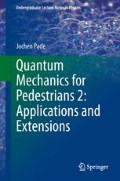Abstract
As we have seen in the preceding chapters, quantum mechanics is a theory that can predict the outcome of measurements with great accuracy—fine for all practical purposes, fapp. However, fundamental questions of interpretation remain open, and this is particularly the case when we are dealing with the concept of ‘measurement’, as we have repeatedly seen.
Notes
- 1.
Indeed, the experimental challenges are enormous if one tries to isolate certain quantum objects from their environment. Serge Haroche and David Wineland developed new ground-breaking experimental methods, making it possible to measure non-destructively those quantum objects and to control them, which was previously thought to be impossible. In 2012, they were awarded the Nobel Prize in physics. As the BBC wrote (http://www.bbc.co.uk/news/science-environment-19879890 (November 2012)), “But for physicists, the import of the pair’s techniques is outlined in a layman’s summary on the Nobel site: they preserve the delicate quantum-mechanical states of the photons and ions—states that theorists had for decades hoped to measure in the laboratory, putting the ideas of quantum mechanics on a solid experimental footing. Those include the slippery quantum-mechanical ideas of entanglement—the seemingly ethereal connection between two distant \(\text {particles}\ldots \) and of decoherence, in which the quantum nature of a particle slowly slips away through its interactions with other matter.”
- 2.
Of course, \(\mathcal {M}\) is not confined to the usual equipment of the physics laboratory. In the case of e.g. Schrödinger’s cat, the cat is the measuring apparatus with the pointer states ‘dead’ and ‘alive’, which measure the state of the radioactive atom.
- 3.
Some remarks on the concepts of ‘open’, ‘isolated’, etc. can be found in Appendix S, Vol. 1.
- 4.
Note: For a grain of sand this is a cat-state. Today, this term is understood as the superposition of two quantum states that are macroscopically distinguishable. Originally, the term referred to an entangled state between a macrostate (cat) and a microstate (radioactive nucleus).
- 5.
Such as time-ordering operators etc.
- 6.
Just as in the example of the beam splitter considered above.
- 7.
There, we do not know the phase-space coordinates of \(10^{23}\) particles (more precisely, we neither can know them nor want to know them).
- 8.
One can imagine that the system itself has lost the information about certain interference terms because it has migrated into the environment. Therefore, the coupling to a great many degrees of freedom is substantial—then the process is virtually irreversible.
- 9.
In vector notation, we have \(\left| z+\right\rangle \cong \left( \begin{array}{c} 1 \\ 0 \end{array} \right) \) and \(\left| z-\right\rangle \cong \left( \begin{array}{c} 0 \\ 1 \end{array} \right) \). Correspondingly, \(\left| \alpha \right\rangle \) is the ‘up’ state of \(\sigma _{x}\).
- 10.
Each state \(\left| \psi \right\rangle \) of the total system \(\mathcal {S} + \mathcal {M}\) can be represented in the form
$$\begin{aligned} \left| \psi \right\rangle =\sum c_{i}\left| u_{i}\right\rangle \left| v_{i}\right\rangle \end{aligned}$$where \(\left\{ \left| u_{i}\right\rangle \right\} \) and \(\left\{ \left| v_{i}\right\rangle \right\} \) are CONS in \(\mathcal {H}_{\mathcal {S}}\) and \(\mathcal {H}_{\mathcal {M}}\) (Schmidt decomposition, biorthogonal decomposition). The decomposition is unique iff the coefficients \(\left| c_{i}\right| ^{2}\) are all different.
- 11.
The theorem of triorthogonal decompositions can be generalized to vectors that are linearly independent (and not necessarily orthogonal), as well as to \(n\) systems (instead of \(3\)).
- 12.
Of course, one knows these interactions in model computations.
- 13.
This pointer variable contains the possible states of the measuring apparatus.
- 14.
Other designations are environmentally induced decoherence or einselection, an abbreviation of environment-induced selection.
- 15.
One can guarantee the uniqueness (or tri- instead of biorthogonal decomposition) by (formally) splitting the environment into two or more systems.
- 16.
E. Joos and H.D. Zeh, ‘The Emergence of Classical Properties Through Interaction with the Environment’, Z. Phys. B59 223-243 (1985); M. Tegmark, ‘Apparent Wave Function Collapse Caused by Scattering’, Found. Phys. Lett. 6, 571–590 (1993).
- 17.
The specific values—whether \(10^{17}\) or \(10^{19}\)—do not matter; just the orders of magnitude are relevant.
- 18.
Other methods to protect decoherence are to rely on the quantum Zeno effect (cf. Appendix L, Vol. 1), or on a special quantum measuring technique (called weak measurement); see Sabrina Maniscalco et al., ‘Protecting entanglement via the quantum Zeno effect’, Phys. Rev. Lett. 100, 090503 (2008), or Yong-Su Kim et al., ‘Protecting entanglement from decoherence using weak measurement and quantum measurement reversal’, Nature Physics (2011), doi:10.1038/nphys2178.
- 19.
W.H. Zurek,‘Decoherence, einselection and the quantum origins of the classical’, quant-ph/0105127 v2, 11.7.2002
- 20.
Quoted in E. Joos,‘Elements of environmental decoherence’, quant-ph/9908008 v1, 2.8.1999. In retrospect, it is clear that it was the referee who did not understand the problem fully.
- 21.
“The unresolved problem today is rather the classical physics itself. How is it possible that there is after all something like the familiar ideal world of classical physics?” Peter Mittelstaedt, ‘Quantum Mechanics at the End of the 20th Century’, Physikalische Blätter 56 (2000), No. 12, p. 65.
- 22.
For example, there are no interferences between fermions and bosons.
- 23.
“The fundamental limitation to an observer’s ability is of a different nature: he must restrict his observations to a finite part of the Universe. Insurmountable difficulties do not arise from having to handle large, complicated systems; rather, they appear with limited and not perfectly isolated systems.” A. Peres, Quantum Theory, p. 346.
Author information
Authors and Affiliations
Corresponding author
Rights and permissions
Copyright information
© 2014 Springer International Publishing Switzerland
About this chapter
Cite this chapter
Pade, J. (2014). Decoherence. In: Quantum Mechanics for Pedestrians 2: Applications and Extensions. Undergraduate Lecture Notes in Physics. Springer, Cham. https://doi.org/10.1007/978-3-319-00813-4_24
Download citation
DOI: https://doi.org/10.1007/978-3-319-00813-4_24
Published:
Publisher Name: Springer, Cham
Print ISBN: 978-3-319-00812-7
Online ISBN: 978-3-319-00813-4
eBook Packages: Physics and AstronomyPhysics and Astronomy (R0)

